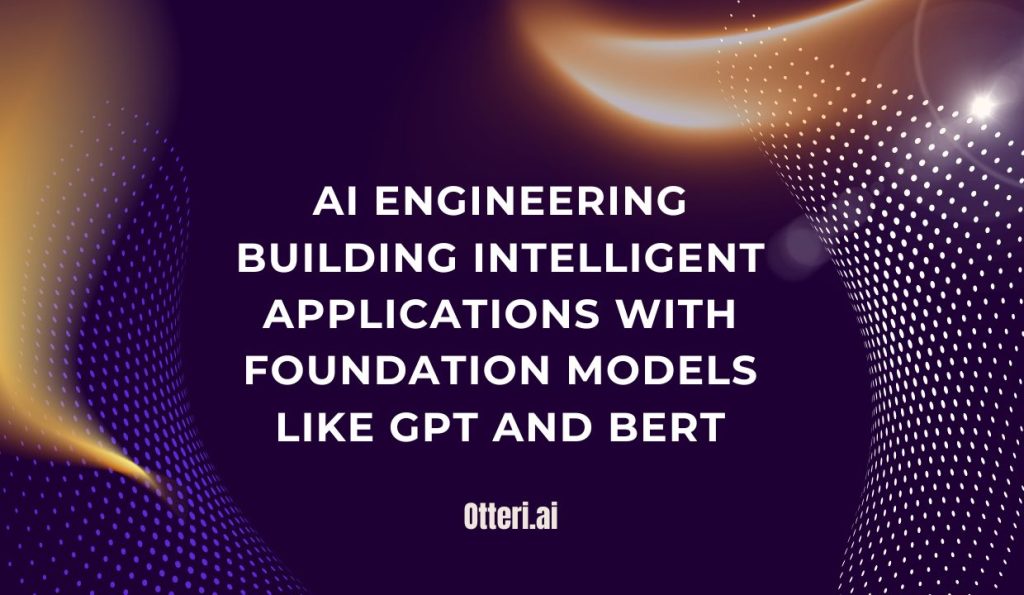
Discover how AI engineering is transforming application development using foundation models like GPT and BERT. Learn the tools, benefits, and real-world use cases.
What Are Foundation Models?
Foundation models are large-scale machine learning models trained on vast datasets that can be adapted to a wide range of downstream tasks. These include language generation, image recognition, translation, summarization, and even reasoning.
Popular examples include:
GPT (Generative Pre-trained Transformer)
BERT (Bidirectional Encoder Representations from Transformers)
DALL·E (for image generation)
CLIP (for visual-language understanding)
Unlike traditional models trained for single tasks, foundation models offer flexibility, generalization, and performance at scale.
The Role of AI Engineering in Application Development
AI engineering blends software engineering with machine learning to build and deploy AI-powered applications. With foundation models, this role becomes even more dynamic and essential.
Key responsibilities include:
Model selection and fine-tuning
Designing infrastructure for inference and training
Deploying models at scale using cloud platforms
Monitoring and optimizing performance
The integration of foundation models simplifies many of these tasks while unlocking immense creative and operational potential.
Benefits of Building with Foundation Models
1. Faster Development Time
Pre-trained models can be fine-tuned for specific tasks, drastically reducing time to deployment.
2. Cost Efficiency
By using existing models, organizations can avoid the high costs of training models from scratch.
3. High Accuracy
These models deliver state-of-the-art performance across diverse AI tasks.
4. Versatility Across Domains
From chatbots to content creation and fraud detection, foundation models adapt easily.
5. Scalability
Most foundation models are cloud-compatible and built for scaling across platforms and user loads.
Use Cases: How Companies Use Foundation Models
1. Customer Support Automation
Enterprises use LLMs (Large Language Models) to build intelligent chatbots that understand context, sentiment, and intent.
2. Personalized Content Generation
Marketing teams use models like GPT to craft SEO-friendly content, personalized emails, and digital ad copy.
3. Healthcare Analysis
AI systems assist in interpreting medical reports, predicting diagnoses, and streamlining communication with patients.
4. Financial Forecasting
Financial firms use foundation models to analyze news, trends, and historical data for real-time market insights.
5. E-commerce Recommendations
Retailers implement smarter recommendation engines to boost customer engagement and conversions.
Tools and Frameworks for AI Engineers
Building with foundation models requires knowledge of machine learning infrastructure and modern development tools. Here are some of the most widely used:
Hugging Face Transformers: Access thousands of pre-trained models and deploy them easily.
OpenAI API: Seamlessly integrate GPT-powered models into apps, websites, and internal tools.
LangChain: Build applications using LLMs for reasoning, chaining tasks, and memory retention.
LLMOps Tools (e.g., Weights & Biases, MLflow): Track experiments, manage model versions, and streamline deployment.
Vector Databases (e.g., Pinecone, FAISS): Store and retrieve embeddings for search, recommendations, and retrieval-augmented generation (RAG).
Challenges in AI Engineering with Foundation Models
While foundation models offer significant advantages, they also bring new challenges:
Bias and Ethics
These models may inherit bias from training data. Ethical AI design is crucial.Data Privacy
Applications handling sensitive data must comply with regulations like GDPR and HIPAA.High Compute Requirements
Running large models demands powerful GPUs and costly cloud infrastructure.Lack of Interpretability
Understanding how models make decisions remains a technical and ethical challenge.Version Control & Maintenance
Keeping up with fast-changing model versions and dependencies can be difficult at scale.
The Future of AI Engineering and Foundation Models
AI engineering is shifting toward modular, composable architectures, where multiple foundation models can work together seamlessly. The rise of multimodal models—those that understand text, images, and audio—will redefine what’s possible with AI.
Additionally, low-code/no-code AI platforms are democratizing access to these tools, enabling product managers and business analysts to contribute to intelligent application development without deep ML expertise.
Final Thoughts
Foundation models are transforming how intelligent applications are engineered. With the right tools, knowledge, and strategic planning, AI engineers can create powerful, scalable, and future-ready solutions. The key is to stay ahead of evolving trends and embrace the possibilities these models bring to the table.
Call to Action:
Ready to take your application to the next level with AI? Start exploring foundation models using platforms like OpenAI, Hugging Face, or LangChain—or consult with an AI engineering expert to kickstart your journey.